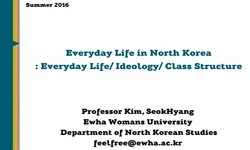Background/Aims: To evaluate the association between the urinary sodium concentration and iodine status in different age groups in Korea. Methods: This nationwide, population-based, cross-sectional study used data from the Korean National Health and N...
http://chineseinput.net/에서 pinyin(병음)방식으로 중국어를 변환할 수 있습니다.
변환된 중국어를 복사하여 사용하시면 됩니다.
- 中文 을 입력하시려면 zhongwen을 입력하시고 space를누르시면됩니다.
- 北京 을 입력하시려면 beijing을 입력하시고 space를 누르시면 됩니다.


Association between urinary sodium levels and iodine status in Korea = Association between urinary sodium levels and iodine status in Korea
한글로보기https://www.riss.kr/link?id=A106604406
-
저자
( Jonghwa Ahn ) (Department of Internal Medicine, Asan Medical Center, University of Ulsan College of Medicine) ; ( Jang Ho Lee ) (Department of Internal Medicine, Asan Medical Center, University of Ulsan College of Medicine) ; ( Jiwoo Lee ) (Department of Internal Medicine, Asan Medical Center, University of Ulsan College of Medicine) ; ( Ji Yeon Baek ) (Department of Internal Medicine, Asan Medical Center, University of Ulsan College of Medicine) ; ( Eyun Song ) (Department of Internal Medicine, Asan Medical Center, University of Ulsan College of Medicine) ; ( Hye-seon Oh ) (Department of Internal Medicine, Asan Medical Center, University of Ulsan College of Medicine) ; ( Mijin Kim ) (Department of Internal Medicine, Asan Medical Center, University of Ulsan College of Medicine) ; ( Suyeon Park ) (Department of Internal Medicine, Asan Medical Center, University of Ulsan College of Medicine) ; ( Min Ji Jeon ) (Department of Internal Medicine, Asan Medical Center, University of Ulsan College of Medicine) ; ( Tae Yong Kim ) (Department of Internal Medicine, Asan Medical Center, University of Ulsan College of Medicine) ; ( Won Bae Kim ) (Department of Internal Medicine, Asan Medical Center, University of Ulsan College of Medicine) ; ( Young Kee Shong ) (Department of Internal Medicine, Asan Medical Center, University of Ulsan College of Medicine) ; ( Won Gu Kim ) (Department of Internal Medicine, Asan Medical Center, University of Ulsan College of Medicine)

- 발행기관
- 학술지명
- 권호사항
-
발행연도
2020
-
작성언어
-
- 주제어
-
등재정보
KCI등재,SCIE
-
자료형태
학술저널
- 발행기관 URL
-
수록면
392-402(11쪽)
-
KCI 피인용횟수
0
- DOI식별코드
- 제공처
- 소장기관
-
0
상세조회 -
0
다운로드
부가정보
다국어 초록 (Multilingual Abstract)
Background/Aims: To evaluate the association between the urinary sodium concentration and iodine status in different age groups in Korea.
Methods: This nationwide, population-based, cross-sectional study used data from the Korean National Health and Nutrition Examination Survey (VI 2-3, 2014 to 2015). We included 3,645 subjects aged 10 to 75 years with normal kidney function and without a history of thyroid disease. Adequate iodine intake was defined as a urinary iodine/creatinine (I/Cr) ratio of 85 to 220 μg/g. The urinary sodium/ creatinine (Na/Cr) ratios were classified as low (< 47 mmol/g), intermediate (47 to 114 mmol/g), or high (> 114 mmol/g).
Results: The median urinary iodine concentration (UIC) was 292 μg/L (interquartile range [IQR], 157 to 672), and the median urinary I/Cr ratio was 195 μg/g (IQR, 104 to 478). Iodine deficiency (< 100 μg/L) and iodine excess (> 300 μg/L) were observed in 11.3% and 49.0% of subjects, respectively. The UIC was significantly associated with the urinary sodium concentration, and the urinary I/Cr ratio was significantly correlated with the urinary Na/Cr ratio (both p < 0.001). The distributions of UIC, urinary I/Cr ratio, and Na/Cr ratio varied among age groups. Low urinary I/Cr and Na/Cr ratios were most common in young adults (age, 19 to 29 years), while high urinary I/Cr and Na/Cr ratios were most common in elderly people (age, 60 to 75 years).
Conclusions: Iodine intake was significantly associated with sodium intake in the Korean population. Our study suggested that an adequately low salt intake might be helpful for preventing iodine excess in Korea.
참고문헌 (Reference)
1 Kim HK, "Usefulness of iodine/creatinine ratio from spot-urine samples to evaluate the effectiveness of low-iodine diet preparation for radioiodine therapy" 73 : 114-118, 2010
2 Caldwell KL, "Urinary iodine concentration:United States National Health and Nutrition Examination Survey 2001-2002" 15 : 692-699, 2005
3 Choi J, "Urinary iodine and sodium status of urban Korean subjects : a pilot study" 45 : 596-598, 2012
4 김원구, "Thyroid Stimulating Hormone Reference Range and Prevalence of Thyroid Dysfunction in the Korean Population: Korea National Health and Nutrition Examination Survey 2013 to 2015" 대한내분비학회 32 (32): 106-114, 2017
5 Pearce EN, "Sources of dietary iodine : bread, cows' milk, and infant formula in the Boston area" 89 : 3421-3424, 2004
6 Rhee MY, "Sodium intake of a city population in Korea estimated by 24-h urine collection method" 67 : 875-880, 2013
7 Lee HS, "Sodium and potassium intake patterns and trends in South Korea" 27 : 298-303, 2013
8 Fuse Y, "Smaller thyroid gland volume with high urinary iodine excretion in Japanese schoolchildren: normative reference values in an iodine-sufficient area and comparison with the WHO/ICCIDD reference" 17 : 145-155, 2007
9 Lee SK, "Relationship of sodium intake with obesity among Korean children and adolescents: Korea National Health and Nutrition Examination Survey" 115 : 834-841, 2016
10 McLean RM, "Measuring population sodium intake : a review of methods" 6 : 4651-4662, 2014
1 Kim HK, "Usefulness of iodine/creatinine ratio from spot-urine samples to evaluate the effectiveness of low-iodine diet preparation for radioiodine therapy" 73 : 114-118, 2010
2 Caldwell KL, "Urinary iodine concentration:United States National Health and Nutrition Examination Survey 2001-2002" 15 : 692-699, 2005
3 Choi J, "Urinary iodine and sodium status of urban Korean subjects : a pilot study" 45 : 596-598, 2012
4 김원구, "Thyroid Stimulating Hormone Reference Range and Prevalence of Thyroid Dysfunction in the Korean Population: Korea National Health and Nutrition Examination Survey 2013 to 2015" 대한내분비학회 32 (32): 106-114, 2017
5 Pearce EN, "Sources of dietary iodine : bread, cows' milk, and infant formula in the Boston area" 89 : 3421-3424, 2004
6 Rhee MY, "Sodium intake of a city population in Korea estimated by 24-h urine collection method" 67 : 875-880, 2013
7 Lee HS, "Sodium and potassium intake patterns and trends in South Korea" 27 : 298-303, 2013
8 Fuse Y, "Smaller thyroid gland volume with high urinary iodine excretion in Japanese schoolchildren: normative reference values in an iodine-sufficient area and comparison with the WHO/ICCIDD reference" 17 : 145-155, 2007
9 Lee SK, "Relationship of sodium intake with obesity among Korean children and adolescents: Korea National Health and Nutrition Examination Survey" 115 : 834-841, 2016
10 McLean RM, "Measuring population sodium intake : a review of methods" 6 : 4651-4662, 2014
11 van de Ven AC, "Longitudinal trends in thyroid function in relation to iodine intake : ongoing changes of thyroid function despite adequate current iodine status" 170 : 49-54, 2013
12 Caldwell KL, "Iodine status of the U.S. population, National Health and Nutrition Examination Survey, 2005-2006 and 2007-2008" 21 : 419-427, 2011
13 Lee J, "Iodine status in Korean preschool children as determined by urinary iodine excretion" 53 : 683-688, 2014
14 Montenegro-Bethancourt G, "Iodine status assessment in children : spot urine iodine concentration reasonably reflects true twenty-four-hour iodine excretion only when scaled to creatinine" 25 : 688-697, 2015
15 Hollowell JG, "Iodine nutrition in the United States. Trends and public health implications: iodine excretion data from National Health and Nutrition Examination Surveys I and III (1971-1974and 1988-1994)" 83 : 3401-3408, 1998
16 Braverman LE, "Iodine and the thyroid : 33 years of study" 4 : 351-356, 1994
17 Tayie FA, "Hypertension, dietary salt restriction, and iodine deficiency among adults" 23 : 1095-1102, 2010
18 Hong JW, "Factors associated with high sodium intake based on estimated 24-hour urinary sodium excretion: the 2009-2011 Korea National Health and Nutrition Examination Survey" 95 : e2864-, 2016
19 Jeon MJ, "Excessive iodine intake and thyrotropin reference interval : data from the Korean National Health and Nutrition Examination Survey" 27 : 967-972, 2017
20 최영식, "Excessive Iodine Status among School-Age Children in Korea: A First Report" 대한내분비학회 32 (32): 370-374, 2017
21 Clark OH, "Excess iodine intake and thyroid function and growth" 1 : 69-72, 1990
22 Xin Sun, "Effects of Increased Iodine Intake on Thyroid Disorders" 대한내분비학회 29 (29): 240-247, 2014
23 Joung JY, "Effect of iodine restriction on thyroid function in subclinical hypothyroid patients in an iodine-replete area : a long period observation in a large-scale cohort" 24 : 1361-1368, 2014
24 Kim JY, "Dietary iodine intake and urinary iodine excretion in normal Korean adults" 39 : 355-362, 1998
25 Hwang S, "Correlation between iodine intake and thyroid function in subjects with normal thyroid function" 143 : 1393-1397, 2011
26 Konno N, "Clinical evaluation of the iodide/creatinine ratio of casual urine samples as an index of daily iodide excretion in a population study" 40 : 163-169, 1993
27 Kim Y, "Associations between reported dietary sodium intake and osteoporosis in Korean postmenopausal women: the 2008-2011 Korea National Health and Nutrition Examination Survey" 29 : 430-439, 2017
28 World Health Organization, "Assessment of iodine deficiency disorders and monitoring their elimination: a guide for programme managers" World Health Organization
29 Kwon H, "Age-specific reference interval of serum TSH levels is high in adolescence in an iodine excess area : Korea National Health and Nutrition Examination Survey data" 57 : 445-454, 2017
동일학술지(권/호) 다른 논문
-
Continuous renal replacement therapy in elderly with acute kidney injury
- 대한내과학회
- Kristianne Rachel P. Medina-Liabres
- 2020
- KCI등재,SCIE
-
Clinical profiles of patients with surgically resected pheochromocytoma and paraganglioma
- 대한내과학회
- Sun Hwa Lee
- 2020
- KCI등재,SCIE
-
- 대한내과학회
- Eun Hye Lee
- 2020
- KCI등재,SCIE
-
Recent advances in diagnostic technologies in lung cancer
- 대한내과학회
- 박혜정
- 2020
- KCI등재,SCIE
분석정보
인용정보 인용지수 설명보기
학술지 이력
| 연월일 | 이력구분 | 이력상세 | 등재구분 |
|---|---|---|---|
| 2023 | 평가예정 | 해외DB학술지평가 신청대상 (해외등재 학술지 평가) | |
| 2020-01-01 | 평가 | 등재학술지 유지 (해외등재 학술지 평가) |  |
| 2011-01-01 | 평가 | 등재학술지 유지 (등재유지) |  |
| 2008-01-01 | 평가 | 등재학술지 선정 (등재후보2차) |  |
| 2007-01-01 | 평가 | 등재후보 1차 PASS (등재후보1차) |  |
| 2005-01-01 | 평가 | 등재후보학술지 선정 (신규평가) |  |
학술지 인용정보
| 기준연도 | WOS-KCI 통합IF(2년) | KCIF(2년) | KCIF(3년) |
|---|---|---|---|
| 2016 | 1.37 | 0.26 | 1.02 |
| KCIF(4년) | KCIF(5년) | 중심성지수(3년) | 즉시성지수 |
| 0.83 | 0.73 | 0.566 | 0.13 |




 KCI
KCI KISS
KISS







